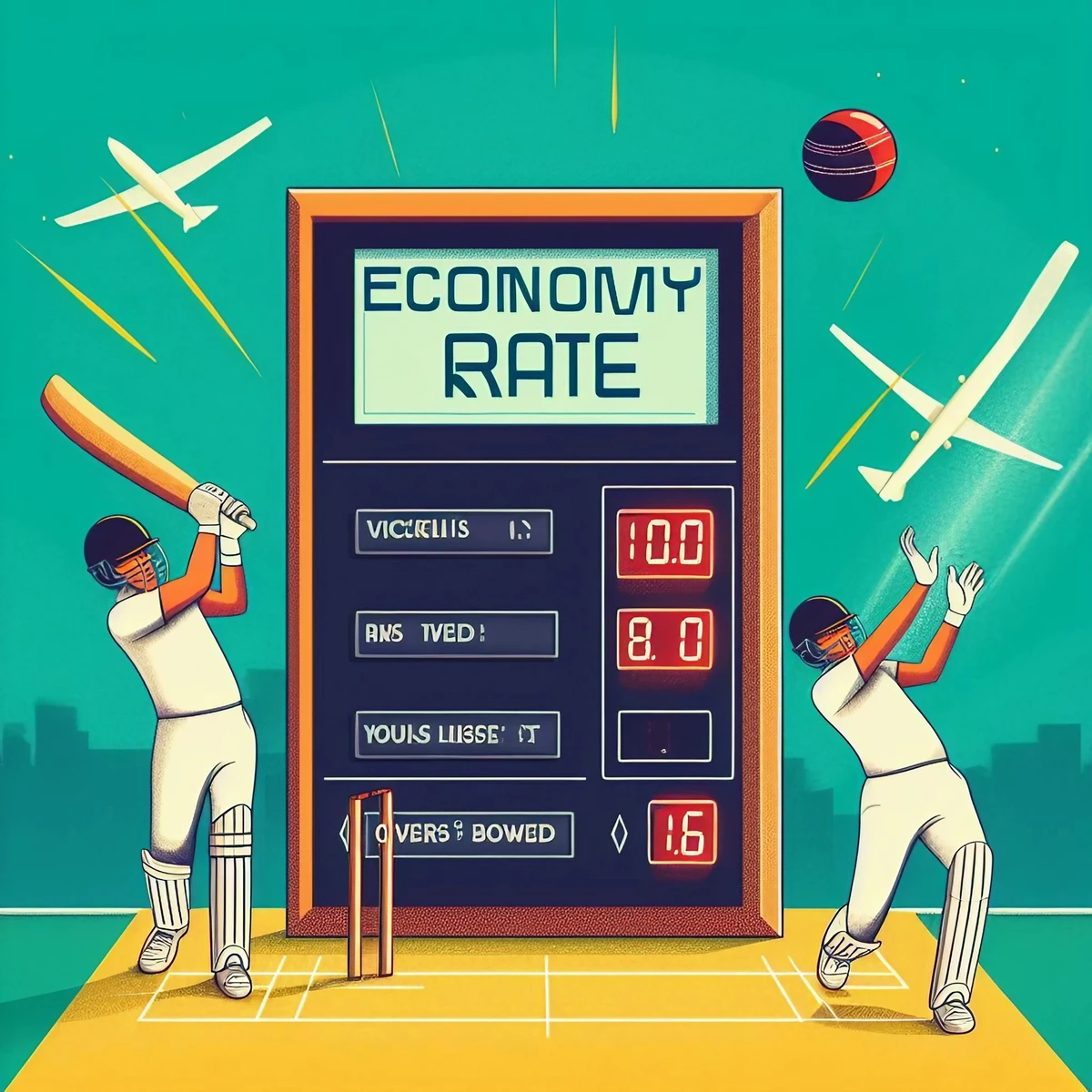Home » Cricket Calculators » Cricket Follow On Calculator
Follow On Calculator
Cricket Follow On Calculator
You can use the cricket follow-on calculator to find out if you can force the opponent to bat again by inviting them to do so.
Get up to ₹20,000 Bonus Every Week!
Get up to ₹20,000 Bonus Every Week!
- UPI, Paytm, gPay & PhonePe withdrawals
- The Biggest Bonuses in India
- Available in four different Indian languages
In Test cricket, the decision of whether to enforce the follow-on requires weighing several factors. Captains must calculate if they have enough of a first innings lead to merit bowling again immediately.
The basic rule is a lead of 200 runs in Tests. But the pitch conditions, bowlers’ fitness and match situation influence the call. Setting a challenging target may be preferred to tiring out the bowlers with back-to-back innings.
Historically, daring captains chasing big wins have enforced the follow-on only to allow opponents back into the match. Wise captains exercise caution and make a measured risk assessment.
TL;DR
Hide- The calculation for enforcing the follow-on in cricket is a crucial decision that teams have to make. It takes into account various factors, including the lead in the first innings and the remaining overs in the match.
- Other considerations like pitch conditions, weather, and the strength of the opposition also play a role in this decision-making process.
- Looking at historical examples, it becomes evident that follow-on decisions can have a significant impact on the outcome of the game.
While urgent in multi-day Tests, the follow-on rule does not apply in ODIs or T20s where matches are done in one innings.
But the concept remains crucial in Test match strategy. An analytical approach to the follow-on calculation can pay dividends or backfire badly.
What is Follow On in Cricket?
The follow on is a rule in multi-day cricket matches, specifically Test matches, that allows the team batting first to force the opposition to bat again immediately after their first innings if they are trailing by a substantial margin.
The key points about follow on in cricket are:
- It applies when the team batting second trails the first innings score by at least 200 runs in a 5 day Test match.
- The captain of the leading team gets to enforce the follow on or decline it.
- If enforced, the trailing team has to bat again right after their first innings.
- Declining the follow on means the leading team bats again to set an even more challenging target.
- The follow on rule aims to shorten Test matches by not allowing the trailing side to waste time.
- It is an optional rule but is rarely declined as psychological pressure on the opponents is high.
So in summary, the follow on allows a dominant team in Tests to force their opponents to bat again immediately to close out victory.
The Importance of Follow On Calculation in Cricket
The follow-on calculation is important because it helps teams strategically assess whether they should enforce the follow-on or not.
When a team batting first achieves a significant lead over the opposing team, they have the option to enforce the follow-on, which requires the opposition to bat again immediately.
However, this decision should not be taken lightly, as it can have significant implications for the outcome of the match.
Assessing the follow-on target is crucial for the batting team. They need to evaluate whether the lead they have obtained is enough to put the opposition under pressure and potentially secure a victory.
To make this assessment, various factors come into play, such as the pitch conditions, the bowling strength of the opposition, and the time remaining in the match.
Understanding the follow-on rule is essential for teams to make informed decisions. By calculating the follow-on target, teams can gauge their chances of success and determine the best course of action.
This strategic calculation allows teams to take advantage of their lead and maximize their chances of winning the match.
In the next section, we will explore the details of the follow-on rule and its implications in cricket matches.
Understanding the Follow On Rule
To fully grasp the follow-on rule in cricket, it is important to analyze the specific criteria that determine when a team can enforce it.
The follow-on rule is a strategic aspect of the game that allows the team batting first to potentially make the opposing team bat again without enforcing the follow-on.
Here are five key points to consider when explaining the follow-on rule:
- Applicability: The follow-on rule is applied in Test matches, where each team plays two innings, and the team batting first has a significant advantage.
- Lead Requirement: To enforce the follow-on, the team batting first must have a lead of at least 200 runs after the first innings.
- Immediate Batting: If the team batting first achieves this lead, they can choose to make the opposing team bat again immediately, thereby increasing their chances of winning the match.
- Follow-On Target: The follow-on target is the lead required for the team batting first to enforce the follow-on. It is calculated by subtracting the opposing team’s first innings total from the team batting first’s total and adding one.
- Failure to Achieve Lead: However, if the team batting first does not achieve a lead of 200 runs, they cannot enforce the follow-on, and the match continues with both teams playing their second innings.
Understanding the follow-on rule and how to calculate the follow-on target is crucial for teams to make informed decisions and strategize effectively in Test matches.
It provides an opportunity for the team batting first to gain an advantage and increase their chances of victory.
Criteria for Enforcing the Follow On
In the game of cricket, teams have the option to enforce the follow-on, which means they can require the opposing team to bat again. This decision is based on specific criteria that aim to ensure fairness and uphold the spirit of the game.
According to the rules set by the International Cricket Council (ICC), a team can enforce the follow-on if they have a lead of at least 200 runs after the completion of the first innings.
To illustrate, if Team A scores 400 runs in their first innings and Team B scores 200 runs in response, Team A has the choice to enforce the follow-on, compelling Team B to bat again.
The follow-on decision is crucial for the team in the lead as it involves considering several factors. These factors include the condition of the pitch, weather conditions, and the strength of the opposition team.
The decision to enforce the follow-on is often influenced by the team’s confidence in their bowlers’ ability to dismiss the opposition quickly once again.
Moving forward, let’s delve into the next section, which focuses on calculating the follow-on target. This step is essential in the follow-on decision-making process.
Calculating the Follow On Target in Cricket
Calculating the follow-on target in cricket is an important part of the game. It involves determining the minimum number of runs a team must be behind by for the opposing team to enforce the follow-on.
This calculation takes into account factors such as the number of innings, the total runs scored, and the current match situation.
Understanding the follow-on target is crucial for teams to plan their gameplay and gain a competitive advantage. It allows them to make strategic decisions based on the score and the state of the game.
Follow-On Target Calculation
Determining the follow-on target in cricket is a crucial calculation that affects the strategic decisions made by the leading team.
The follow-on target is calculated by subtracting 200 runs from the team’s first innings total. This target serves as a benchmark for the team batting second to avoid being asked to bat again.
The follow-on strategy is employed by the leading team to put additional pressure on the opposing team and increase their chances of winning the match.
It acts as a psychological barrier for the team batting second, highlighting the dominance of the leading team and their ability to enforce the follow-on.
Calculating the follow-on target emphasizes the importance of a substantial first innings lead. It adds pressure on the team batting second to perform exceptionally well in order to avoid being forced to bat again.
This calculation ensures a fair opportunity for both teams to compete and sets the stage for an exciting and competitive game. It creates a clear objective for the leading team and adds an element of strategy to the match.
Factors Affecting Follow-On
The follow-on target calculation in cricket is influenced by two main factors: the team’s first innings total and the number of overs remaining in the match.
The decision-making process regarding the follow-on is crucial as it allows the dominant team to enforce the follow-on, requiring the opposing team to bat again without a change in innings.
To determine the follow-on target, 200 runs are subtracted from the team’s first innings total. However, if the number of overs remaining in the match is less than the average number of overs taken to score 200 runs, the target is adjusted accordingly.
- Net Run Rate Calculator: How to Calculate Run Rate in Cricket
- Cricket Batting Average Calculator
- Cricket Batting Strike Rate Calculator
- Cricket Bowling Average Calculator
- Cricket Bowling Strike Rate Calculator
- Cricket Economy Rate (Econ) Calculator
- Cricket Follow On Calculator
- Cricket Runs per Over Calculator
This calculation ensures that the batting team faces a challenging target while considering the time remaining in the match.
Understanding these factors is essential for teams and captains to make informed decisions about whether to enforce the follow-on. It provides them with a strategic advantage that can potentially influence the outcome of a cricket match.
In the next section, let’s explore the significance of the follow-on in cricket.
Importance of Follow-On
The importance of the follow-on in cricket lies in the advantages it brings to the team that enforces it. The follow-on target is calculated based on the lead that the team batting first has over the team batting second.
By enforcing the follow-on, the team batting second is required to bat again without the opposition’s involvement, which can provide several benefits.
One advantage is the psychological pressure it puts on the team batting second. The follow-on target creates immense pressure, increasing the likelihood of mental fatigue and collapse under the weight of the lead.
Another advantage is the physical exhaustion it can cause to the opposition. Continuously batting for long periods can tire them out, making them more prone to making mistakes and losing wickets.
Enforcing the follow-on also allows for better time management. The team batting first gains control over the match’s tempo, dictating the pace and potentially securing victory within the allotted time.
Strategically, enforcing the follow-on allows the team batting first to maintain the upper hand. They have already demonstrated their dominance and put the opposition on the back foot.
Furthermore, enforcing the follow-on increases the chances of winning the match outright, without relying on the unpredictable nature of the fourth innings.
Factors Influencing the Decision to Enforce the Follow On
One important factor in deciding whether to enforce the follow on in cricket is the team’s first innings lead. If a team has a significant lead, they have the option to put additional pressure on the opposing team by making them bat again immediately. However, there are other considerations that come into play when making this decision.
Tactical factors play a crucial role in determining whether to enforce the follow on. The team must evaluate the condition of the pitch and the performance of their bowlers.
If the pitch is deteriorating quickly or the bowlers are fatigued after a long innings, it may be wise to give them a rest and let the opposing team bat again.
The team’s confidence in their own batting lineup also influences this decision. If they believe they can chase down any total, they may choose not to enforce the follow on and give their batsmen a chance to rest and recuperate.
Weather conditions can also have a significant impact on the decision-making process. If bad weather is predicted for the remaining days of the match, the team enforcing the follow on has the advantage of potentially winning the match before the weather interferes.
On the other hand, if the weather is expected to improve, the team may decide to bat again and allow their bowlers more time to rest and recover.
Considering these factors allows the team to make an informed decision that maximizes their chances of victory.
Moving on to the subsequent section about ‘follow on calculation in test matches’, it is important to understand the mathematical aspects of this decision-making process.
Follow On Calculation in Test Matches
In Test matches, calculating the follow-on involves considering two main factors: the advantage it provides and the strategy behind it.
The follow-on advantage refers to the benefit gained by the team that enforces it. This advantage allows them to exert additional pressure on the opposing team, potentially leading to a victory.
On the other hand, the follow-on strategy involves carefully assessing the match situation, including the lead acquired by the team batting first and the condition of the pitch. This assessment helps in making an informed decision on whether to enforce the follow-on or not.
Determining the Follow-On Advantage
In Test Matches, the follow-on strategy is a calculated risk taken by a team to gain an advantage over their opponents.
This strategy involves considering several factors, including the team’s lead, the pitch conditions, the strength of the opposition, and the remaining time in the match.
By enforcing the follow-on, a team can apply additional pressure on the opposing team, tire out their bowlers, and potentially secure an outright victory. However, there are also risks involved, such as giving the opposition a chance to recover and potentially save the match.
In the next section, we will explore the follow-on strategy in more detail and discuss its implications.
Follow on Strategy
Continuing from our previous discussion on determining the follow-on advantage, the follow-on strategy in Test Matches involves a calculated approach to gain an advantage over the opposition. It requires careful consideration of various factors.
One important aspect of this strategy is the follow-on target calculation. The follow-on target is the number of runs by which the team batting first must be ahead of the team batting second for the follow-on to be enforced. While the usual target is set at 200 runs, it can vary depending on the match situation and conditions.
The decision to enforce the follow-on requires the captain and coach to assess several factors. They need to consider the pitch conditions, weather forecast, the strength of their bowling attack, and the time remaining in the match.
By analyzing these factors, they can determine whether enforcing the follow-on will give their team a better chance of winning or if they should bat again to extend their lead further. This thoughtful decision-making process maximizes their chances of victory.
Follow On Calculation in One-Day Internationals (ODI)
In the game of cricket, the decision to enforce a follow-on in One-Day Internationals (ODIs) is determined by specific factors rather than a fixed calculation.
Unlike in Test matches where a team must be at least 200 runs behind, in ODIs, the target for a follow-on is set at 150 runs. This takes into account the limited overs format and the need to balance competition and time constraints.
Several factors are considered when deciding whether to enforce a follow-on in an ODI match. These factors include the difference in scores between the two teams, the number of overs remaining in the match, the strength of the batting lineup of the team batting second, the pitch conditions, weather forecast, and the overall match situation, including the target set by the team batting first.
By carefully considering these factors, the team management can make an informed decision on whether to enforce the follow-on or choose to bat again. This approach ensures that the game remains competitive while taking into account the unique aspects of the ODI format.
It allows for flexibility and excitement, liberating the audience from the traditional follow-on calculation used in Test matches.
Follow On Calculation in T20 Matches
In T20 cricket matches, the follow-on rule does not apply. Unlike longer formats like Test matches and One-Day Internationals, where the follow-on rule is traditionally used, T20 matches have a different dynamic.
In T20s, teams have a fixed number of overs, typically 20, to score as many runs as they can. There is no provision for enforcing a follow-on target in this fast-paced format.
Instead, in T20 matches, the team batting first sets a target for the team batting second. The team batting second then tries to chase down the target within the allotted overs. If they succeed, they win the match. If not, the team that batted first emerges as the winner.
The absence of a follow-on rule in T20 matches allows for more flexibility and excitement. It encourages aggressive batting and ensures that each team has an equal opportunity to showcase their skills and potentially turn the match in their favor. This adds to the thrill and unpredictability of T20 cricket.
Historical Examples of Follow On Decisions
The follow-on rule in cricket plays a significant role in determining the outcome of a match. It allows the team that has a substantial lead to force the opposing team to bat again, putting them under immense pressure.
Throughout the history of cricket, captains have made influential follow-on decisions that have had a major impact on the game and have showcased the strategic aspect of the sport. These decisions can often be game-changing, leading to exciting comebacks or decisive victories.
Follow-On Significance Explained
Understanding the historical significance of follow-on decisions in cricket reveals the strategic impact of this calculated tactic. It is a crucial decision made by the team that has a significant lead in the first innings and aims to enforce the follow-on on the opposing team.
Here are five notable examples of follow-on decisions that have shaped the game:
- England’s decision to enforce follow-on against Australia in the 1981 Ashes series, leading to their famous Headingley victory.
- India’s decision to follow-on against Australia in the 2001 Kolkata Test, resulting in a historic comeback and a series win.
- West Indies‘ decision to enforce follow-on against England in the 1980 Old Trafford Test, resulting in a dominant victory.
- South Africa’s decision not to enforce follow-on against Australia in the 2006 Sydney Test, leading to a draw and series victory.
- Australia’s decision to enforce follow-on against Pakistan in the 1999 Hobart Test, resulting in a massive win.
These examples highlight the strategic importance of follow-on decision making, showcasing the potential for both triumph and comeback in the game of cricket.
Influential Follow-On Decisions
In the game of cricket, there have been several instances where influential decisions have shaped the course of the match. One such decision is the choice to enforce the follow-on, which can have a strategic impact on the game.
Factors such as the team’s lead, the condition of the pitch, and the strength of the opposition influence this decision.
Let’s take a closer look at some notable examples where the follow-on decision played a crucial role in determining the outcome of the match:
- In the Ashes 2005, 4th Test, England enforced the follow-on and went on to win the match by 3 wickets.
- In the India vs. Australia match in 2001, India chose not to enforce the follow-on and ended up winning by 171 runs.
- In the West Indies vs. Australia match in 1999, Australia enforced the follow-on, but West Indies managed to win by 1 wicket.
- In the England vs. South Africa match in 1924, South Africa decided not to enforce the follow-on and eventually won by 109 runs.
These examples demonstrate the significant impact of the follow-on decision on the outcome of the game.
Now, let’s explore the overall influence of the follow-on tactic in cricket.
Impact of Follow on On the Game
The follow-on rule in cricket has a significant impact on the dynamics of the game. It not only affects the team’s morale but also plays a crucial role in determining the strategy to achieve the follow-on target. Here are five ways in which the follow-on rule influences the game:
- Psychological Advantage: When a team enforces the follow-on, it can demoralize the opposition and establish dominance. This advantage can impact the opposition’s performance and decision-making on the field.
- Fatigue Factor: If a team is required to bat again after failing to reach the follow-on target, it can lead to physical and mental exhaustion. This can result in reduced performance, slower reflexes, and increased chances of making mistakes.
- Time Pressure: The follow-on rule puts pressure on the batting side to score quickly and avoid being enforced to follow on. This can lead to aggressive batting and potential risks.
- Strategic Considerations: The team enforcing the follow-on can strategically plan their bowling and fielding tactics to exploit the opposition’s exhaustion, both mentally and physically.
- Momentum Shift: If a team successfully achieves the follow-on target, it can create a significant shift in momentum. This boost in confidence puts immense pressure on the opposition.
The impact of the follow-on in cricket goes beyond the numbers on the scoreboard. It influences team dynamics, strategic decisions, and the overall flow of the game. Understanding its implications is essential for players and fans alike.
Conclusion
The follow-on calculation in cricket is an important aspect of the game that determines whether a team should enforce it or not. It takes into account factors like the lead in the first innings and the number of overs remaining in the match.
Other considerations, such as pitch conditions, weather, and the strength of the opposition, also come into play when making this decision.
Historical examples demonstrate the impact of follow-on decisions on the outcome of the game.
Frequently Asked Questions
What does follow on mean in cricket?
In Test cricket, a follow-on is when the captain of the team batting first forces the team batting second to bat again immediately after their first innings because of a substantial deficit in scores.
How is follow-on score test calculated in cricket?
In Tests, the follow-on target score is calculated by taking the first innings total and adding 200 runs to it. For example, if Team A makes 350 in its first innings, the follow-on target for Team B would be 350 + 200 = 550.
What is follow-on score for 404?
If Team A scores 404 runs in their first innings of a Test match, the follow-on target score for Team B would be 404 + 200 = 604 runs. So Team B would have to trail by 604 runs or more to be forced to bat again.
Get up to ₹20,000 Bonus Every Week!
Get up to ₹20,000 Bonus Every Week!
- Fastest Indian Rupees Withdrawals
- The Biggest Bonuses in India
- Available in four different Indian languages
Other Cricket Calculators
Latest Cricket Posts
Claim 200% Welcome Bonus
For a limited time, every new member can claim 200% Welcome Bonus upon registration up to ₹15,000. Read to bet?













